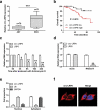Circular RNA circ-LRP6 facilitates Myc-driven tumorigenesis in esophageal squamous cell cancer
- PMID: 32867570
- PMCID: PMC8291805
- DOI: 10.1080/21655979.2020.1809922
Circular RNA circ-LRP6 facilitates Myc-driven tumorigenesis in esophageal squamous cell cancer
Abstract
Circular RNA (circRNA) circ-LRP6 was recently proven to be a pivotal player in various human diseases. Nevertheless, its role in esophageal squamous cell cancer (ESCC) remains unknown. In the current study, we investigated the expression level, biological function and mechanism of circ-LRP6 in ESCC. Circ-LRP6 was significantly upregulated in ESCC tissues and correlated with malignant clinicopathological characteristics and poor prognosis. Knockdown of circ-LRP6 evidently reduced ESCC cell viability, colony formation and invasion. Circ-LRP6 was mainly located in the cytoplasm and could sponge miR-182 to increase the expression of Myc, a well-documented proto-oncogene. Importantly, circ-LRP6 depletion significantly retarded tumor growth in vivo. And silencing of miR-182 or overexpression of Myc effectively rescued the attenuated aggressive phenotype of ESCC cells caused by circ-LRP6 knockdown. Therefore, our data indicate that circ-LRP6 is a novel oncogenic circRNA in ESCC, targeting the circ-LRP6/miR-182/Myc signaling may be a promising therapeutic approach for ESCC patients.
Keywords: Esophageal squamous cell cancer; Myc; circular RNA; miRNA; prognosis.
Conflict of interest statement
No potential conflict of interest was reported by the authors.
Figures






References
-
- Bray F, Ferlay J, Soerjomataram I, et al. Global cancer statistics 2018: GLOBOCAN estimates of incidence and mortality worldwide for 36 cancers in 185 countries. CA Cancer J Clin. 2018;68(6):394–424. - PubMed
MeSH terms
Substances
LinkOut - more resources
Full Text Sources
Medical
